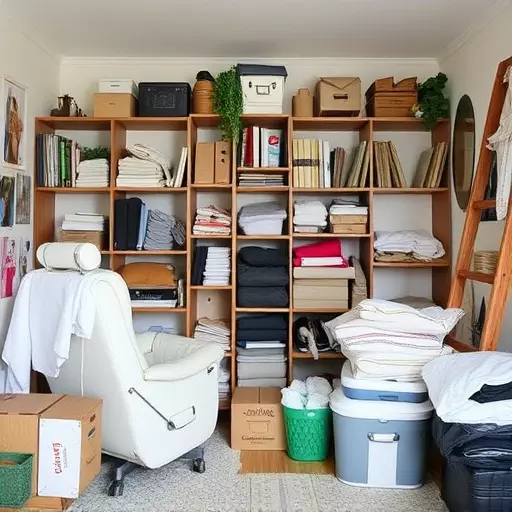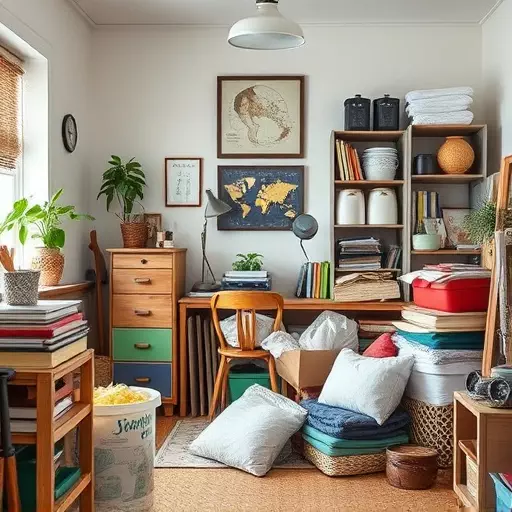A tidy home is not just about aesthetics; it boosts well-being, productivity, and lifestyle satisfaction. Key steps include identifying clutter causes (storage issues, poor time management, emotional attachments), using appropriate tools (storage containers, labels, vacuum cleaners), sorting items into keep/donate/discard piles, implementing storage solutions tailored to item use frequency, and addressing emotional attachment through digital documentation or designated sentimental spaces. Regular room-by-room tidying and clear goals are crucial for maintaining a clutter-free home through effective Home Organization and Decluttering practices.
Are you tired of living in a sea of disarray? It’s time to embrace the power of Home Organization and Decluttering. This comprehensive guide explores the transformative benefits of a clutter-free home, from improved mental clarity to increased productivity. We delve into the root causes of messy spaces and equip you with essential tools and proven techniques for effective decluttering. Get ready to transform your living areas and cultivate lasting organization.
- Understanding the Benefits of a Clutter-Free Home
- Identifying the Root Causes of Messy Spaces
- Essential Tools for Effective Decluttering
- Step-by-Step Guide to Organize Your Living Areas
- Techniques to Overcome Emotional Attachment to Possessions
- Maintaining Long-Lasting Organization: Tips and Tricks
Understanding the Benefits of a Clutter-Free Home

A clutter-free home is more than just an aesthetic preference; it’s a game-changer for your well-being and lifestyle. When you embrace home organization and decluttering, you create a peaceful and functional space that fosters productivity and reduces stress. Imagine walking into a room where everything has its place—no more piles of papers on the couch or cluttered countertops in the kitchen. This simple transformation enables better flow, making daily tasks easier and more efficient.
Moreover, a decluttered home promotes mental clarity. With less visual noise, you can focus better, think more clearly, and make important decisions without distractions. Home organization is not just about getting rid of stuff; it’s about arranging your belongings in a way that supports your lifestyle and enhances your overall satisfaction with living spaces.
Identifying the Root Causes of Messy Spaces

Many people struggle with keeping their homes organized and clutter-free, but understanding the root causes of messy spaces is the first step toward effective home organization and decluttering. Often, disorder stems from a combination of factors such as lack of storage solutions, poor time management, or even emotional attachment to items. Identifying these triggers is crucial in implementing lasting changes.
For instance, if a room feels cluttered due to an overwhelming amount of possessions, considering minimalism or adopting a “one-in, one-out” policy could be beneficial. Efficient home organization also involves setting clear goals and creating systems that work for the individual or family. By addressing the underlying reasons, individuals can develop tailored strategies to transform their spaces from chaotic to calm and clutter-free.
Essential Tools for Effective Decluttering

When tackling a messy home, having the right tools is essential for effective decluttering and achieving successful home organization. The key to efficient sorting and discarding lies in simple yet versatile items that can transform your space. One indispensable tool is a set of clear storage containers in various sizes; these are perfect for categorizing and storing smaller items like accessories, craft supplies, or paperwork. A robust set of hanging organizers for cabinets or closets ensures your garments, towels, or linens remain tidy and easily accessible.
Don’t underestimate the power of labels—they make organizing a breeze! They help identify the contents within each container, making it simple to keep things in order and locate specific items quickly. Additionally, invest in a good-quality vacuum cleaner with powerful suction to tackle dust and debris accumulated over time. This will ensure your space appears clean and fresh as you work through the clutter-busting process, fostering motivation throughout.
Step-by-Step Guide to Organize Your Living Areas

Creating a clutter-free living space starts with a comprehensive home organization and decluttering process. Begin by sorting items into categories: keep, donate/sell, or discard. This initial step helps to visualize what truly matters and makes it easier to part ways with unnecessary possessions. Next, invest time in creating designated storage solutions for each category. Assign specific areas for frequently used items like remotes, books, and magazines, ensuring they always have a place to return to.
For less accessible but still important items, utilize under-bed storage containers or empty shoe boxes. Labeling these containers makes retrieval effortless and contributes to a more organized flow throughout your living areas. Start small, focusing on one room at a time, and gradually work your way across the entire home. Regularly maintaining this system through quick tidy-ups will prevent clutter from building up again.
Techniques to Overcome Emotional Attachment to Possessions

Overcoming emotional attachment to possessions is a critical aspect of effective home organization and decluttering. Many people find it challenging to part with items due to sentimental value, even if they no longer serve a practical purpose. A helpful technique is to categorize belongings into keep, donate, or discard piles. Take a moment to acknowledge the memories associated with each item before making a decision. Consider whether the item could be replaced or if its emotional significance can be preserved through digital photos or keepsakes.
Another effective strategy involves practicing mindfulness and intentional living. Before acquiring new items, ask yourself if it aligns with your values and lifestyle. This mindful approach can reduce the number of unneeded possessions over time. Additionally, creating specific areas for sentimental items can help in managing emotional attachments. Designate a special box or shelf to store meaningful memories, allowing you to easily access and appreciate them without overwhelming your living spaces.
Maintaining Long-Lasting Organization: Tips and Tricks

Keeping a home organized is an ongoing process, but with some simple tips, you can achieve long-lasting organization and declutter effectively. Start by setting clear goals; define the purpose of each room and what you want to achieve visually. This will help you make informed decisions about storage solutions and furniture placement.
Consistency is key; dedicate a few minutes each day to putting things back in their place, removing clutter, and maintaining order. Regularly reviewing your storage systems and discarding or donating items no longer needed is essential for long-term organization. Labels, bins, and containers can be useful tools, ensuring everything has its place and making the process of keeping a tidy home more manageable.
Achieving a clutter-free home is not just about aesthetics; it’s a journey towards improved mental clarity and efficiency. By understanding the benefits, identifying root causes, and employing essential tools and techniques discussed in this article, you can transform your living spaces into organized oases. Embrace the process, overcome emotional attachments, and maintain long-lasting organization through consistent effort. Remember, a tidy home supports a peaceful mind, empowering you to focus on what truly matters. Welcome to your more organized future!


